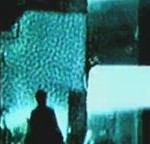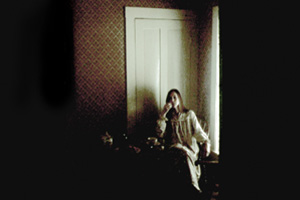May 16th & 17th: A Weekend Exhibition with Walter Ungerer
On May 16th and 17th, renowned experimental filmmaker and media artist Walter Ungerer will host a weekend exhibition of his work at the Center for Digital Art. Sorting through a career in filmmaking that goes back nearly five decades, Ungerer has selected short films and video art pieces that represent not only his unique visual style, but his growth as an artist over time: from the celluloid 60s and 70s, to the video 90s and the digital days of the 21st century. Throughout the weekend’s program, Ungerer will be present to introduce each film, discuss his processes and answer questions from the audience.
INSTALLATIONS HERE AND THERE
The full weekend’s program includes an ongoing gallery installation of select video art pieces and two screening sessions of short films, both at CDA. See below for full program description. We are pleased to be working in collaboration with the Brattleboro Museum & Art Center to present “All the Days of the Year,” a video-art installation by Walter Ungerer opening at BMAC on May 9th (opening reception at 5pm).
ABOUT WALTER UNGERER
The origins of Walter Ungerer’s work as an avant-garde experimental filmmaker date back to the halcyon days of the genre itself. As a fixture of The Village underground film and art scenes in New York City in the 1960s, Ungerer made film pieces that employed a number of different experimental techniques: concrete images are layered and blended together into abstraction, animation and photography are combined, even the celluloid itself is colored, scratched, drawn upon and distorted to add new dimensions to the developed images. In these days, Ungerer worked alongside Al Maysles, Stan Vanderbeek, and learned from Shirley Clark.
In 1969, Ungerer made Ubi Est Terram Oobiae? which was selected by the Museum of Modern Art in New York to represent American experimental film to the rest of the world in a touring film series. In the next few years the Oobieland films (there are five parts), received awards at such experimental film festivals as Ann Arbor, Foothill, Bellevue, and Baltimore.
Soon after, Ungerer left New York for a job teaching filmmaking at Goddard College in Plainfield, VT. For thirty-three years he lived in Vermont creating feature length experimental narrative films: The Animal, The House Without Steps, The Winter There Was Very Little Snow and Leaving the Harbor. The Green Mountain State plays a key role in Ungerer’s films of this era, not only are local actors and crew employed almost exclusively, but the bucolic landscape of Vermont became such a profound inspiration for these stories that it becomes a character itself: beautiful and intriguing, yet eerie and unpredictable.
Walter Ungerer is an artist for whom adaptability has proven as necessary as the drive for self-expression itself. Ahead of the curve, he understood the opportunity of digital video and computer editing for filmmaking back in the 1990s: it was more compact and cost-effective than bulky 16mm and 35mm, and the slightly-off picture quality of the first DSLR cameras suited Ungerer’s visual style. His process began to change – the films became much shorter in length, from the 75 to 90 minute narrative films to 5 to 15 minute computer generated works. It was a move from the long form to the short form, much like the difference between prose and poetry in literature. The projects were also more frequently produced. What remained however was Ungerer’s intuitive approach to experimental techniques, and his predilection for the themes of nature, earth, the unknown and unknowable.

A hazy sunset created with early digital animation tools appears in Ungerer’s “A Warm Day After A Cold Winter” (1995)
Walter Ungerer is the recipient of several national and regional awards: the American Film Institute filmmaker grant, a National Endowment on the Arts grant, a National Endowment of the Humanities grant, and several Vermont Council on the Arts grants
THE PROGRAM
FRIDAY, MAY 16th
– 6pm – Opening Reception – Video Installation:
The Syracuse Tapes (1990) 9:00 min. (looping)
– 7pm – Screening Begins:
Introduction by the Artist
Ici (2013) 6:33 min.
Kingsbury Beach (1999), 06:21 min.
Monarda (2010) 10:07 min.
Parva Sed Apta Mihi (2012) 17:02 min.
Blue Parrot (2009) 12:23 min.
Green Eye (2012), 6:36 min.
noCom (2014) 9:09 min.
SATURDAY, MAY 17th
– 6pm – Opening Reception – Video Installation:
A Warm Day Comes After a Cold Winter (1994) 5:42 min. (looping)
– 7pm – Screening Begins:
Introduction by the Artist
Ubi Est Terram Oobiae? (1969) 5 min.
Clouds (2012) 6:47 min.
The Bird Feeders (2008) 14 min.
City of the Angels (2013) 11:35 min.
Epitaph (2008) 9:37 min.
And All This Madness (excerpt) (2004) 6:33 min.
Q & A with filmmaker at end of each program
BOTH DAYS
Each film with its own monitor for individual viewing
A Lion’s Tale (1968) 13:35 min.
Anna’s Amazing Moving Animals (1994) 2:20 min.
Birds 2/93 (1993) 2:06 min.
Inalienable (2008) 7:45 min.
Introduction to Oobieland (1969) 9:01 min.
Meet Me Jesus (1966) 13:48 min.
Such As It Is (2006) 11:47 min.
The Awakening (2002) 9:45 min.
The Window (1997) 3:13 min.
Untitled 2.1.2 (2001) 9:48 min.
Below, One of Ungerer’s newest films, Mauvais Garçon/Bad Boy, which was recently featured in the 4th Annual Words and Video Exhibition at the Center for Digital Art in October, 2013.
MAUVAIS GARÇON BAD BOY from Walter Ungerer on Vimeo.


